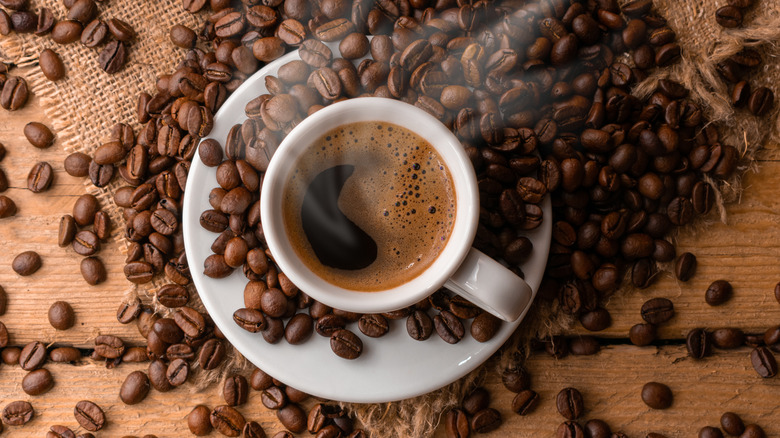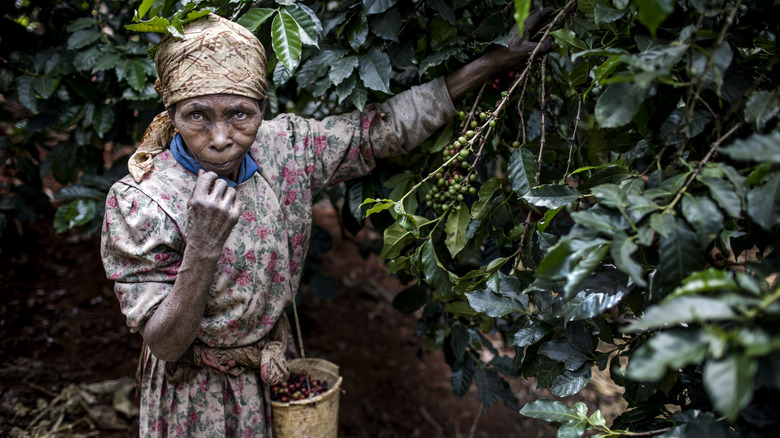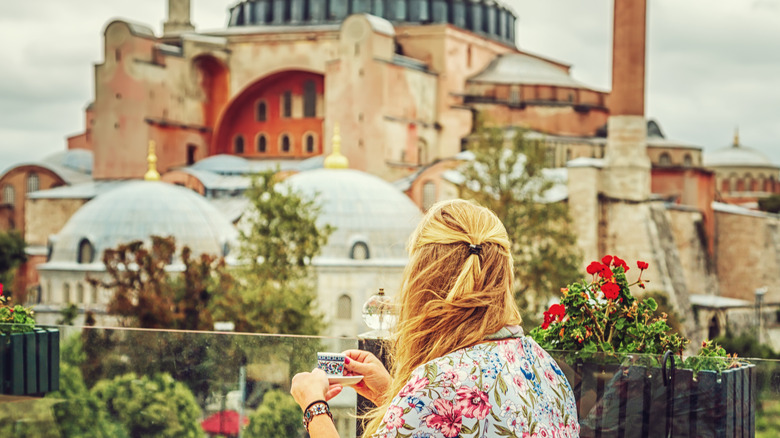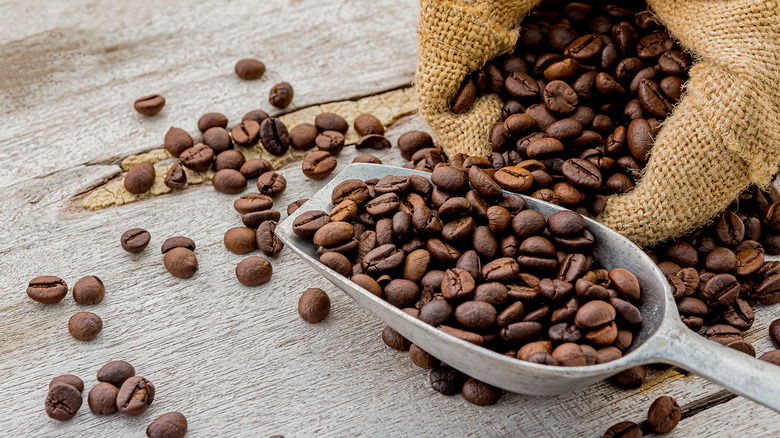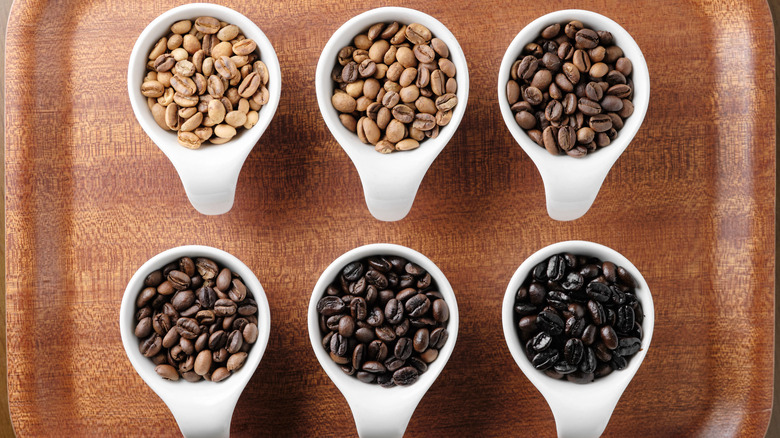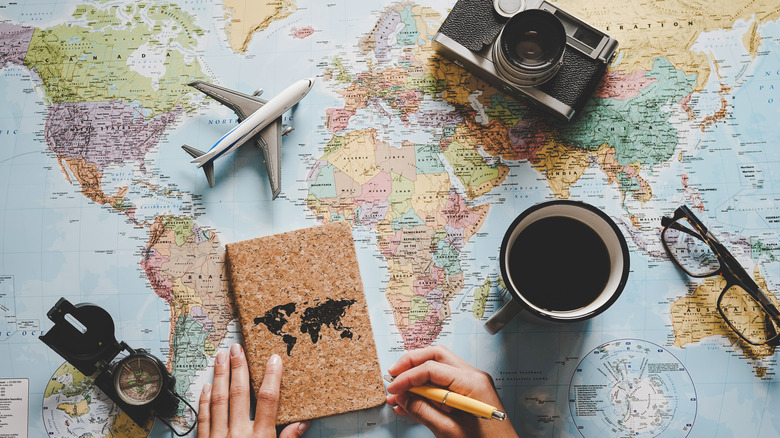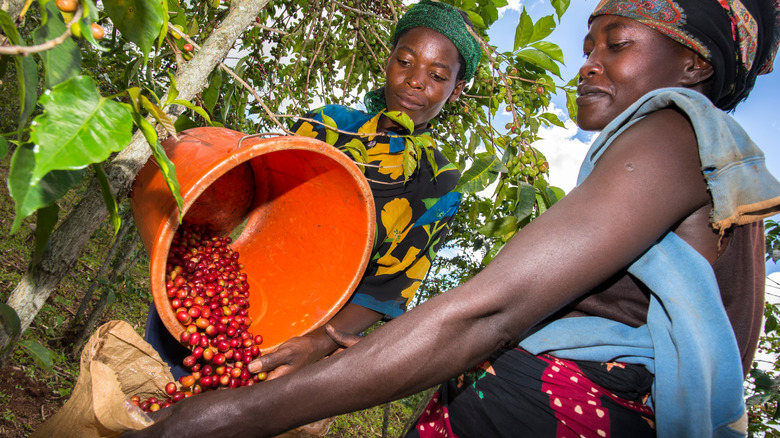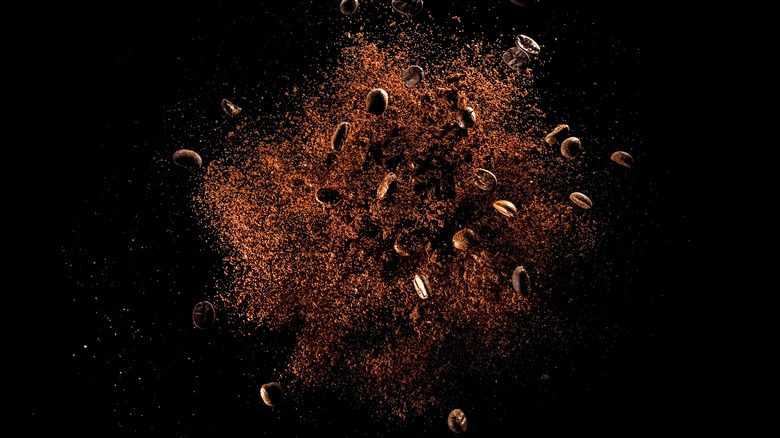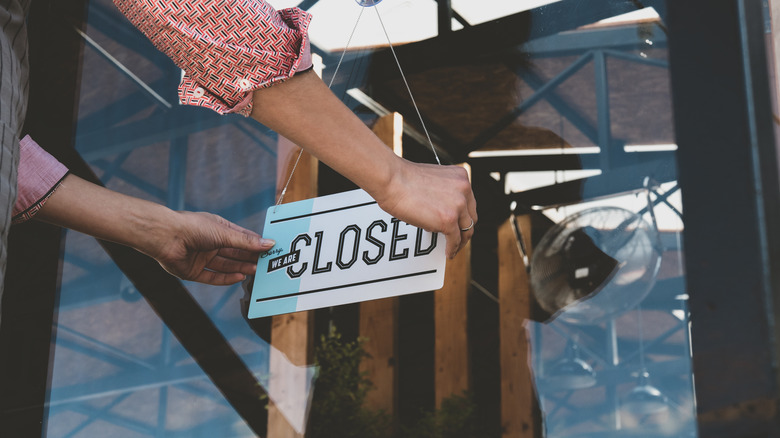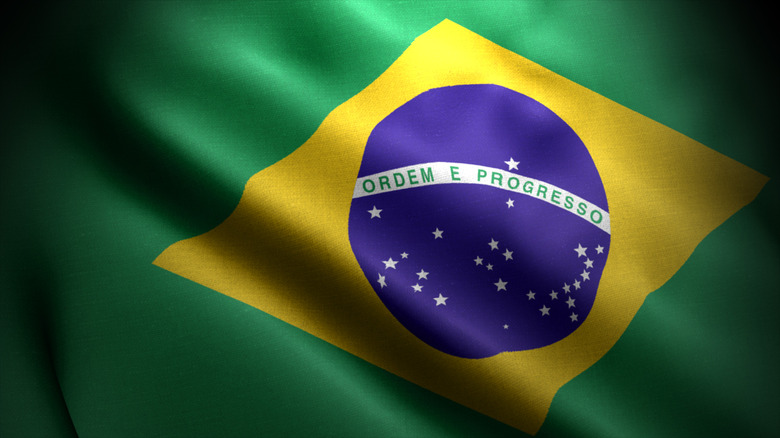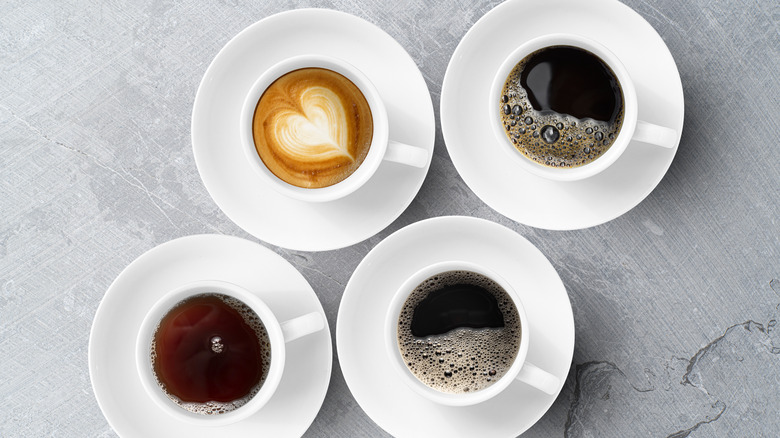Everything You Wanted To Know About Coffee
Believe it or not, there are people out there who do not start their mornings with a steaming cup (or three) of joe! For most of us, though, coffee is synonymous with the a.m., and a dose of caffeine in the mornin' can help us start our days on the right foot. Even though many of us choose to indulge in a healthy serving of java every day, much of the history and science behind coffee is veiled from the public eye.
We took a deep dive to learn everything that a true coffee-lover should know about our beloved brew. These little magic beans are truly that: magic — from their epic and deep history to their roasting process and beyond. So go grab a cup of your favorite roast and settle in — we are about to tell you everything you need to know about coffee and how it came to be what it is today.
Coffee has a rich history
Legend has it that coffee beans were originally discovered by an Ethiopian goat herder often referred to as Kaldi the Great (via Voltage Coffee). He watched his goats become highly energetic and active after consuming some little red berries around 850 AD, detailed The Atlantic. Word started to spread and "by the 16th century, [coffee] was known in Persia, Egypt, Syria, and Turkey," Voltage Coffee explained.
The Turkish people of the Ottoman empire introduced coffee in what was Constantinople. This ended up being a defining moment in coffee's history. Small coffee shops began popping up throughout Constantinople. These coffee shops rapidly became community-oriented places to engage in lively conversations and political debates (via Voltage Coffee).
Coffee houses became safe zones for people to talk and exchange information, which led to them being nicknamed "Schools of the Wise." The popularity of coffee shops spread throughout Europe, and by the 17th century, the golden era of coffee had dawned.
Three historical waves shaped the way we consume coffee today
As with most trends, coffee has experienced peaks, valleys, deaths, and rebirths along its journey. Historians and coffee buffs consider there to be three different, iconic eras of coffee, often referred to as the "three waves of coffee." Each wave represents a big change to the coffee industry at large; each one shaped the way we consume coffee today (via Essence Coffee).
The first wave of coffee occurred in the early 1800s. The rapid increase in coffee consumption marked this era. With increased demand, coffee became more a commodity and less of a luxury (Essence Coffee). The second wave began much later in the 1970s. The wave is marked by the most ubiquitous coffee shop, Starbucks. It should come as no surprise that Starbucks transformed the way we consume coffee. Whether you love Starbucks or have a "friends don't let friends drink Starbucks" bumper sticker on your car, the historical value of the siren and her green-apron-clad team runs deep.
The third wave of coffee began a mere three decades after the second wave. In the early 2000s, people began to become aware of the origins of their coffee beans and their production methods. The public became very keen on purchasing "good" coffee in terms of ethics, thus introducing a new kind of coffee consumption, explained Essence Coffee.
There are two main types of coffee beans
There are two main varieties of coffee beans. Beans generally fall into one of two categories: arabica and robusta. According to Crush Mag, arabica beans are usually longer and flatter in shape and produce softer milder-flavored coffee. Robusta beans, on the other hand, are smaller and more robust in shape and flavor. Robusta beans also pack a much bigger punch of caffeine. In fact, they typically have 50 to 60% more caffeine than arabica beans.
Robusta coffee shrubs also tend to be heartier than arabica plants. And because they produce more coffee, they are the most cost-effective option. Due to this, they are often used to create instant coffees and blends, Crush Mag explained. Conversely, arabica beans are more sensitive and require higher quality sun, shade, and soil for cultivation. They do best when grown at elevations of 600 to 2,000 meters (roughly 2,000 to 6,500 feet) and can easily be damaged by cold temperatures and pests (via The Roasterie).
Coffee flavors are varied and detailed
Wine enthusiasts know that wine has over 120 flavor and aroma influencing components (via Wine Folly). No shade to our fave adult beverage, but coffee is even more complex, confirmed The Wall Street Journal. Each one of these components creates a unique and overwhelming sensory experience.
According to the coffee experts at Coffee and Health, using a flavor wheel is a great way to map out coffee preferences. Your preferences are predictably determined by the aroma and taste of each roast. Even if two roasters are given identical beans, how they choose to roast them will influence how we, as consumers, will experience them.
Some of the more understandable categories on the coffee bean flavor wheel include chocolate-like, nutty, floral, mild, and tangy. However, with so many flavor profiles and combinations for your palette to separate, some of the adjectives are a bit more nebulous. This includes flavor-descriptors such as enzymatic, creosol, carbony, and alliaceous.
Understanding the main roasting profiles
Roast can dictate how coffee plays across your tongue. There are four main types of coffee roasts: light, medium, medium-dark, and dark. Each variable roast can either bring out the subtle flavors of a specific bean or kill it (via Crush Mag).
Light roasts tend to have a mild flavor. They are roasted gently, but not so much that they develop an oily surface. Medium roasts are often called "American roasts" and are roasted a bit more aggressively than light roasts. They are not roasted to the extent that they have an oily surface, but they do offer a bit more richness of flavor, according to Crush Mag.
Medium-dark roasts are typically roasted enough to obtain a deep, dark brown color. They end up with some surface oils, which gives these beans a slightly bittersweet aftertaste and a richer mouthfeel. As you probably suspect, dark roasts get super toasty! They are often roasted to achieve their trademark dark and oily surface. The more surface oil created through the roasting process, the less acidic the coffee will taste (via Crush Mag).
Great coffee comes from all over the world
With the third wave of coffee upon us, many of us are becoming acutely aware of the origin of our beans. But did you know that great coffee can be grown all over the world? That said, they do fare best in locations with some altitude and tropical climates (via Crush Mag). Typically found in areas near the equator, coffee plants thrive in nutrient-rich soil, moisture-rich air, and some shade.
Kona, Hawaii is a well-known coffee-growing region. The nutrient-rich volcanic soil and tropical temps allow their signature beans to grow well. Colombia and Brazil both grow and transport tons of coffee each year. Their climates are perfect for coffee bean cultivation. Yemen, many Indonesian islands, and Ethiopia also boast exceptional conditions for growing coffee plants (via Crush Mag). If you haven't yet gotten your caffeine-deprived paws on a mug of Ethiopian Yrgacheffe coffee, we recommend you do so ASAP.
Coffee beans need a lot more than harvesting to become drinkable
We get it! Rolling out of bed and trying to tackle your French press is a feat that daunts us all in the early morning hours. But that is just one step of many that makes coffee drinkable.
Fresh coffee berries, often called cherries, are harvested from the plants through a laborious and time-consuming process. According to the National Coffee Association, "A good picker averages approximately 100 to 200 pounds of coffee cherries a day, which will produce 20 to 40 pounds of coffee beans." Once the cherries have been harvested, they need to be processed — and quickly, to prevent them from going bad. Two modalities can be employed from here: the wet method or the dry method. The dry method is commonly used in areas where water is limited. This step aims to bring the moisture content of the beans below 11% (via National Coffee Association).
Next, the beans need to be milled and hulled, and often polished. After the beans have been sorted, they are ready for distribution as green coffee beans. These get sent to the roasters, who work their magic to create the joe we all know and love so much.
Roasting coffee is quite a process
Much like the harvesting process, roasting coffee beans to perfection requires precision, patience, and a ton of skill. According to Giesen Coffee Roasters, most beans arrive with humidity of around 10%, which is what the farmers work to achieve. Coffee roasters, however, need to dry the beans more before beginning the browning process. It's during this process that the aroma of the beans comes alive.
The process of browning the beans ignites what is called the "Maillard reaction," Giesen Coffee Roasters explained. The Maillard reaction essentially means that the natural sugars and amino acids in the beans start reacting, causing them to change color and become flavorful. After a few minutes in the browning phase, the beans begin to change shape and "crack" to signify the next step in the process.
From here, each roaster uses their own style to create the flavor profile they are looking for. The roast time and the roast degree heavily influence the beans' flavor and varies roaster to roaster (via Giesen Coffee Roasters). Once the roast is complete, roasters have to cool the beans efficiently to lock in their desired flavor.
People have actually tried to ban coffee drinking
In 1615, coffee arrived in Venice, Italy, according to the National Coffee Association. People dubbed it the "bitter invention of Satan," which, of course, did not help increase its popularity. Rumors began to spread, perpetuating the rumor that coffee is dangerous. Not long after, Sultan Murad IV put coffee drinkers of the Ottoman Empire to death, and King Charles II sent spies to infiltrate London coffee houses, explained History. Historically, coffee houses have served as shelters for revolutionaries and political debates, the site explained. This meant coffee houses threatened the hierarchal structure and order — thus they were not embraced by those in power.
King Charles II feared spreading new information and propaganda and banned coffee houses from operating (History). The ban lasted less than two weeks before it was eventually overturned. Shortly after that, coffee houses became known as "penny universities" because you could gain access to relevant debates for the price of a cup of coffee, explained History. Coffee shops remain places to gather, discuss ideas, and engage in intellectual debates.
Coffee is 'one of the most widely consumed beverages' in the world
Whether you are a lifelong Folger's fan, a specialty coffee connoisseur, or a Nespresso fanatic, you are in good company. According to a National Coffee Association study, most Americans drink coffee each day (via Reuters). The study estimated that around 64% of the population in the United States drinks coffee on any given day. That statistic sky-rockets when the worldwide population is included (via E-Imports).
"Coffee is one of the most widely consumed beverages," a study in The New England Journal of Medicine confirmed. From 2020 to 2021, an estimated 166.63 million 60-kilogram bags of coffee were consumed around the globe (via Statista). And despite our appetite for productivity here in the United States, the U.S. is not the highest coffee-consuming country in the world — we actually come in 14th place, according to 2020 data. Still, there are approximately 24,000 coffee shops in America, and that number is expected to double in the coming years (via E-Imports).
Brazil is the largest coffee-producing country in the world
Brazil boasts beautiful people, gorgeous beaches, fun festivals, and incredible music. They are also the leading coffee producer in the world (via World Atlas). In 2016 alone, Brazil produced nearly 2.6 million metric tons of coffee beans, and the trend has stayed strong. In fact, Brazil has been the largest coffee producer worldwide for more than a century, according to World Atlas.
Three of Brazil's southeastern states are home to the majority of their coffee-cultivating land. In total, Brazil has around 27,000 square kilometers (about 10,400 square miles) of land that they use to produce coffee. This is around the same size as the entire state of Massachusetts. Since much of Brazil's climate, temperature, and location are ideal for growing coffee, they can sow many different kinds of beans (via World Atlas).
One remarkable tradition that Brazil uses in its coffee production is the dry method of processing fresh coffee berries. As opposed to other growers who use water to aid in the processing of beans, Brazilian growers spread their beans out in the sun and allow them to dry that way (via World Atlas). Talk about a sustainable approach!
Many of the harmful rumors about coffee and caffeine consumption are just rumors
Historical bans on coffee have failed — perhaps because coffee is basically the nectar of the gods. However, many people still perpetuate rumors about the assumed negative effects of coffee. Most of these rumors are just that: rumors. Cue the Fleetwood Mac song.
As with all things, though, coffee is best consumed in moderation. The experts at Johns Hopkins assert that drinking a moderate amount of coffee may actually have health benefits. "Caffeine is the first thing that comes to mind when you think about coffee," Diane Vizthum, research nutritionist for Johns Hopkins University School of Medicine explained. "But coffee also contains antioxidants and other active substances that may reduce internal inflammation and protect against disease."
However, caffeine has been known to increase symptoms in individuals with anxiety. It can cause sleep disturbances, increased blood pressure, and an increased heart rate. If you are pregnant or breastfeeding, check with your doctor before reaching for a cup of joe. While some caffeine during pregnancy is unlikely to have negative repercussions, it is always best to consult your physician (via Johns Hopkins).
Coffee provides health benefits
Not only have the coffee-is-poison rumors been debunked, but it also turns out that a moderate amount of coffee is actually good for you (via Johns Hopkins). Studies have discovered evidence showing that regular coffee drinkers are less likely to die of stroke, diabetes, heart disease, and kidney disease. Female coffee drinkers, in particular, are 26% less likely to develop colorectal cancer, explained Johns Hopkins. Helpful liver enzymes are also higher in regular coffee drinkers.
Coffee has even been proven to help ward off Parkinson's disease. And for those who have already been diagnosed with the disease, coffee may help them "better control their movements" (via Johns Hopkins). Plus, coffee can help prevent the development of Alzheimer's and dementia in general.
While DNA strand breakage is normal, it can often lead to cancer and tumors if your cells do not repair it properly. Thankfully, a bit of coffee may help, explained Johns Hopkins. Dark roasted coffee can actually lessen this breakage.
How much coffee should you really consume?
The health benefits of coffee range from being fascinating to being downright coveted. But too much of a good thing can often lead to negative health consequences. It is safe for adults to consume up to 400 milligrams of caffeine per day, according to Johns Hopkins. For reference, a single 8-ounce cup of coffee has around 95 milligrams.
Additionally, Johns Hopkins cautions coffee drinkers to only consume an amount of coffee that feels good. Some people feel unwell after more than a cup or two, and it is paramount to listen to your body. And while black coffee may be incredibly healthy and advantageous to consume, additives can create an overall unhealthy beverage. By adding sugar and milk or cream, the health impacts of coffee can be negated. Not to mention the cavities that many ensue after drinking sugary coffee day after day!

